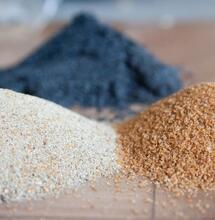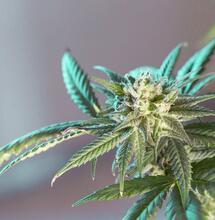The Importance of Nitrogen

One of the essential foods cannabis plants need in order to thrive is Nitrogen. One of the most plentiful elements on Earth, and constituent of all life, nitrogen helps plants develop and maintain leaves, roots, fruits, or in the case of cannabis—nice healthy buds.
Experienced cannabis growers are well familiar with the N-P-K formula. The "N" here stands for Nitrogen, one of the three nutrients cannabis crops demand in the most substantial amounts. Nitrogen supports a healthy plant formation and takes part in fundamental cellular processes of the plant.
Plants absorb nitrogen through the soil, usually in the form of Nitrate nitrogen. That is the most common form of the element used in fertilization.
Nitrogen helps form plant tissues and cells. It creates amino acids, which are the building blocks essential for vital processes in the plant organism. Nitrogen is found in the nucleic acid that forms the DNA and helps pass traits and characteristics to new plants. The element is also found in chlorophyll, the green compound required for photosynthesis.
Plants exposed to more considerable amounts of Nitrogen accelerate photosynthesis and develop a more robust organism. However, throughout its lifecycle, a Cannabis plant needs varying amounts of Nitrogen. Which is why growers should always have suitable nutrient feed at hand and dispense accordingly with the growth stage, depending also on the cannabis strain cultivated.
How to detect Nitrogen deficiency?
Like any nutrient deficiency, when cannabis plants are undernourished with Nitrogen, it will manifest on the plant.
Several different reasons can result in a Nitrogen deficiency:
- Most often, nitrogen deficiencies happen due to underfeeding, but there could also be a problem with the growing medium or the roots.
- Overfeeding the plant with potassium, zinc, manganese, and chloride may result in improper nitrogen uptake.
- Low temperatures in your growing medium may damage roots and paralyze nutrient absorption.
- The use of salt-based chemical fertilizers can also disbalance Nitrogen uptake.
The tell-tale signs something is wrong:
- The pH of your medium is rising too high, which may indicate a nutrient uptake issue.
- The appearance of pale green or yellowing leaves makes the nutrient deficiency issue obvious. In the early stage, discolorations are noticeable near the base of the plant, among the most mature leaves. If the discoloration spreads to the plant's upper part, it's a sign of an advanced-stage deficiency.
- If there's a poor formation of the plant and its buds. The low number of bud sites and early flowering indicates a deficiency. A fast reaction is needed to prevent a disastrous harvest.
- Plants are vulnerable and contract diseases or pest infestation. Growing a cannabis strain that is genetically resistant to infections and its immune system fails should sound the alarm.

How to address Nitrogen deficiency issues?
Diagnosis of any deficiency begins with testing the pH of your water; this pH value should be in the range from 6.0 to 7.0. Following that, check the pH of the soil container or other grow medium, if any. For soil, pH should be in the range of 5.8 and 6.8; for hydroponics is between 5.5 and 6.5. If the values show outside these parameters, work to normalize the pH.
Determine your strategy how you deal with deficiency:
- Increase your nutrient feed-in strength 1 ml at a time until leaves recover their green color.
- For a faster reaction, use a nitrogen booster or a foliar feed.
What else can you do?
- Use nutrients with low salt contents or opt for organic nutrients only, to avoid other Nitrogen disbalances.
- Growing in a hydroponic system or Coco can reduce the possibility of a nitrogen deficiency.
- Most nutrient solutions for hydroponic systems indicate the optimal amounts to use and it's hard to go wrong there.
How to detect nutrient lockout?
Cannabis plants may begin to yellow and leaves to curl, and this may mean there's a nutrient lockout that looks like a nutrient deficiency. You may think your plants are undernourished when in fact, they have had more than sufficient amounts of nutrients.
If you suspect there's a nutrient lockout going on in your garden, again test for water pH. The value should stand somewhere between 6.0 and 7.0. Secondly, check the pH of your soil, which should be in the range of 5.8 and 6.8. If the pH is below or above these numbers, your plants are likely to struggle absorbing nutrients properly.
Correcting a nutrient lockout will require several key steps:
- Pause all dispensing of nutrients;
- Flush plants with water to free up nutrients. Downpour fresh, pH-balanced water in the pots to resolve salt buildup that may be blocking nutrient absorption.
- Let the soil dry out before watering again. If you water too soon, it may cause rot on the roots.
- Water the plant a few more times before proceeding with a new round of nutrients.
How to prevent nitrogen issues?
Of course, the best course of action is to avoid a nutrient deficiency from happening. For that matter, growers should regularly check water and soil pH levels. The use of organic nitrogen solutions is more than recommended.
If you suspect that you've used too many nutrients, you can exercise a round of flushing your garden instead of waiting to see what happens.
Cannabis plants demand significant amounts of Nitrogen, but specific strains may dictate particular regimes of those amounts. Nitrogen will assist the formation of vigorous, healthy cannabis crops. So, always pay attention to your nutrient solutions and how you dispense it.
Good luck growing!







